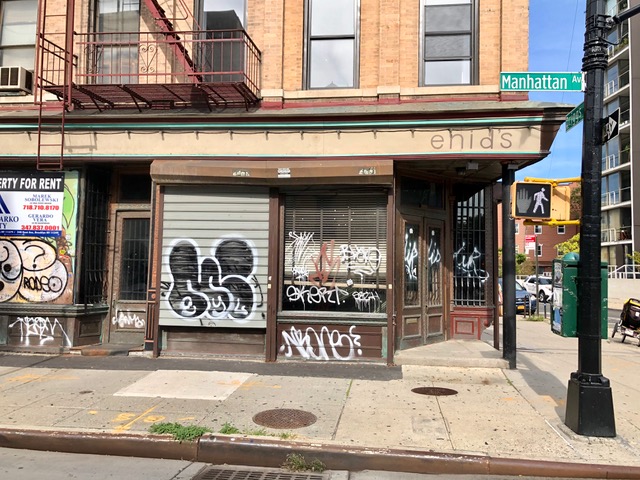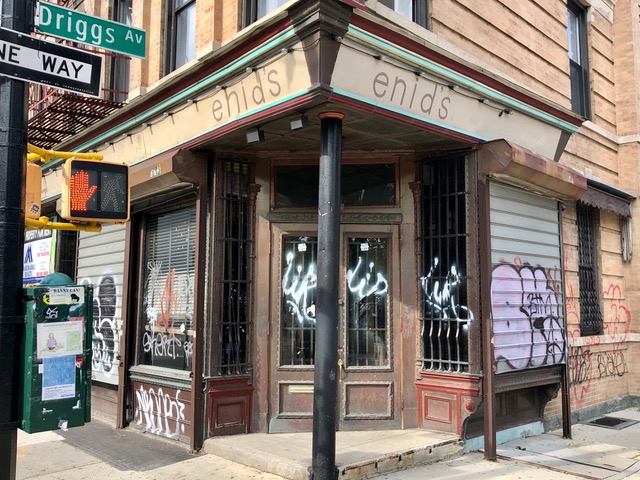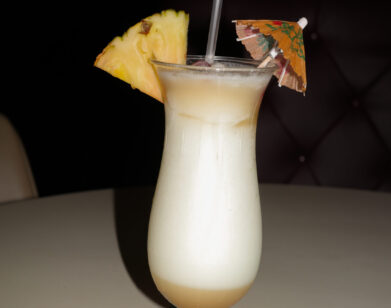Nostalgia
A Tour of Vanishing Williamsburg in David Goodwillie’s New Novel “Kings County”

It’s been unexpectedly heartbreaking to read the latest novel from David Goodwillie, Kings County, a down-and-dirty ode to New York City, during this current summer of lockdowns and urban escape strategies. Goodwillie guides his young, reckless, hard-working characters through the ins and outs of the early 2000s Brooklyn music scene—and eventually into the mystery of a drug-dealer friend’s unexpected death. Coursing through this novel is nostalgia for a New York that no longer exists due to the increasing gentrification of the past decade, but that nostalgia is amplified in light of the current state of New York. Goodwillie paints his cityscapes with such vivid and knowing prose, the city grows around the reader like a warm glove, leading many of us to desperately, deeply miss New York as we tumble through these clever pages. In honor of the New York that a lot of us can’t currently access, Goodwillie takes us on a virtual tour of some of the bygone Brooklyn hangouts that are key locales in his novel.
———
Kings County is a love story set amid the burgeoning music scene of early 21st-century Brooklyn. The main characters Audrey Benton and Theo Gorski are struggling to make it after moving to New York—Audrey as a manager of indie bands, Theo as a junior book editor—when they meet and fall in love. But soon an old friend disappears under mysterious circumstances, and long-buried secrets begin to surface, threatening not just their relationship, but their very lives. I wanted to write an urban tableau, in turn edgy and poignant, that harkened to a Brooklyn of a not-too-distant past, when rents were cheap and music permeated every dream, every conversation, every night. Williamsburg. Greenpoint. Bushwick. To young, creative souls desperate to escape small town upbringings, these were mystical places representing freedom and reinvention, a life out there waiting.
But of course it couldn’t last. The music or the neighborhood. Indie gave way to hip-hop. Warehouse lofts became condo towers. Farmers markets cropped up and ferry service began. Today, the Brooklyn of Kings County no longer exists, but the memories linger. Of bleary-eyed sunrises on black tar rooftops. Sweat-drenched dance parties in bomb shelter basements. Walks of shame that were anything but. Here are a few of my favorite landmarks from those years, all of which appear in novel, if no longer in real life.
———

Enid’s
As I write this, the Enid’s website can still be found online, a digital relic of sorts. Click on the dinner menu and you’ll come across that famous footnote that made all but the steeliest of vegetarians smile: “Our meat comes from happy cows and chickens humanely raised by kind-eyed farmers.” Everything about Enid’s, the pioneering Greenpoint eatery, was “kind-eyed,” from the daytime waitstaff, always dependably more hungover than the clientele, to the evening bartenders, who served up everything but attitude.
Enid’s (where, in the book, Audrey lands her first waitressing job) opened in 1999, on a desolate block on the wrong side of McCarren Park. Greenpoint in those days was a working-class enclave of Polish immigrants sprinkled with Italians and Puerto Ricans at its edges. At first, Enid’s was seen as a threat, a symbol of what was to come. But the restaurant aged well, and within a few years has grown into a neighborhood institution, hosting dance parties by night and stroller-pushing brunchers by day. If you hung out in that high-ceilinged establishment for long enough, you could chart the course of your next 15 years. At some point, the restaurant adopted a motto that winked at the changing neighborhood: “Enid’s: Since before you were here.” And yet the restaurant itself seemed perpetually stuck in time—a summer night, perhaps, in 2005. Years passed, and then, just like that, a note appeared on the door one day in early 2019. Enid’s was finally closing, not because of rising rents, the owners said, but something more whimsically fitting: it was just time to move on.
———

Glasslands Gallery
Lana Del Rey played there. And MGMT. And TV on the Radio, FKA Twigs, Deer Tick, Bon Iver, and Grimes. Glasslands opened in 2006, down by the waterfront, though “waterfront” was a misnomer back then, since no one thought of the Williamsburg shoreline, strewn as it was with rusted oil tanks and corrugated fencing, as anything but an afterthought—a haphazard destination for amateur taggers and urban spelunkers. Glasslands fit the environment. It was the most DIY of venues, casual and chaotic, with pillars marring the site lines and acid-trip artwork lining the walls—a club-size teenage rec room, nightly graced by ethereal talent.
I saw my last Glasslands show in 2013, the year before it closed. I stopped by late to catch The Echo Friendly, a Brooklyn band of the moment, and ran into a poet friend at the bar. She’d just met a boy named Wild, and the two of them were joking about getting his name tattooed on her arm. “Ah, Brooklyn,” I thought and left them to it. The next morning, I woke up to a text from her. She was in the hospital. She’d tripped outside the club and hit her head on the curb. But it was okay, she said. Mr. Wild was still with her. He’d stayed by her side all night. And he was still there months later, when she got the tattoo. “Mrs. Wild,” it read, in elegant script. When they broke up—and what ink-committed couple doesn’t?—she got an “e” added to the end, in honor of a more enduring Wilde—Oscar—who would never break her heart.
Glasslands itself proved less enduring. Unable to keep up in Williamsburg’s overheated real-estate market, the club suffered the even greater indignity of being replaced by the new worldwide headquarters of Vice Media, a company that once championed the very aesthetic it now plundered and helped destroy. Of all the things Williamsburg lost, irony is not one of them.
———

Rosemary’s Greenpoint Tavern
The first time I went to Rosemary’s Greenpoint Tavern, I made the same mistake everyone made and assumed it was in Greenpoint. I got off the L and headed north through McCarren Park until Bedford Avenue abruptly ended with no Rosemary’s in sight. This was long enough ago that cell phones weren’t yet ubiquitous (at least among my friends), and a person, a few drinks in, could still get lost in a new neighborhood. But I spied a phone booth, called information (these were things people once did, I swear), and eventually doubled back and found the bar half a block south of where I’d started.
I saw her as soon as I walked in: the woman behind the bar. If the second part of the tavern’s name was misleading, the first was all too accurate. It was Rosemary herself, and this was clearly her place. She was in her early 70s then (though she looked 10 years older and acted 30 years younger), dressed to the nines as she poured out a row of perfect shots. I looked around the jewel-box room, with its red barstools and cozy booths. The glow of holiday lights set the mood (though it wasn’t winter), and the punk-heavy jukebox sustained it. I can’t remember if I spoke with Rosemary that first night, but I would in future, dozens of times. If it was late enough, she’d start telling stories (she’d been slinging drinks since 1955, so had plenty to choose from) and no one ever interrupted. She didn’t serve “cocktails” (she called them “mixed drinks”); she didn’t take credit cards (but refused for years to get an ATM machine); and she didn’t abide drunken behavior (and personally escorted unruly customers out the front door). What she did do is welcome everyone, from MTA workers still in their orange work vests, to punk kids in strategically-ripped shirts and Doc Martens, to drag queens downing courage-building shots before strutting off to perform around the corner. At some point, the bar got listed in a travel guide—Fodor’s or Lonely Planet—and wide-eyed tourists started showing up. But Rosemary accepted them, too (even as she taught them to tip properly). She finally retired last year, at 86, though not by choice. A hedge fund had bought up the buildings on either side and were squeezing her out. I stopped by on one of the last nights. The music was just as loud as ever, and Rosemary was sitting on the customer side of the bar, reminiscing with regulars. For a moment, I forgot the larger circumstances. Then I saw her tears.
———

Kokie’s
Yes, it really did exist, and yes, it really was named Kokie’s. Williamsburg’s very own 1990s drug den was a Puerto Rican dive bar on Berry Street (now The Levee) where stepped-on cocaine was sold from a little closet in the windowless back room. There was even a curtained booth where you could line up to do your key bumps—or so I’ve heard (ahem). Rumor was the owners paid off the local precinct captain for years, which would explain how Kokie’s managed to stay open until 2001, despite half the Northside knowing about it. The end came predictably, through loose lips and blog posts. Word eventually spread through downtown Manhattan, resulting in waves of desperate souls taking 3 a.m. cab rides across the river. The bar was raided, once, and then again, until it finally closed for good. Now, almost 20 years later, an apparel company sells T-shirts with the red Kokie’s logo. When I see one, I can’t help but roll my eyes, wondering if the 20something wearing it even knows that the place was real. At least, that’s what I used to do, before I gave in and ordered one myself. Why not? That’s how nostalgia works these days.






